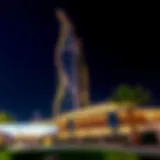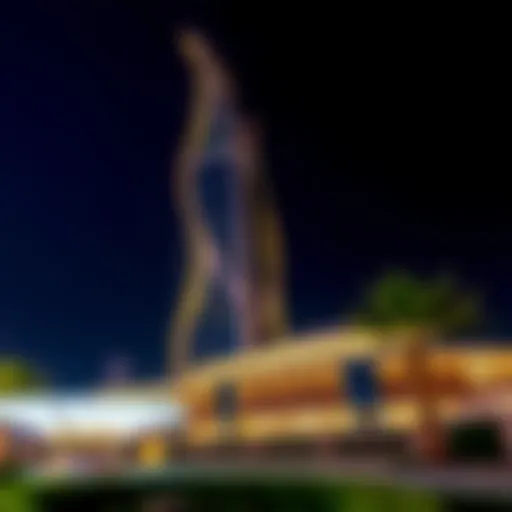Discover Souk Naif Plaza: Culture and Commerce in Dubai
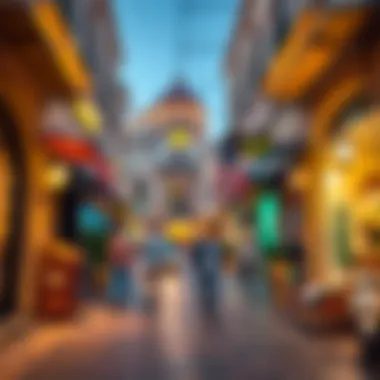

Intro
Souk Naif Plaza stands as more than just a marketplace; it embodies the essence of Dubai's rich cultural tapestry while also serving as a dynamic hub for commercial activities. Nestled in the heart of the emirate, this plaza has become a vital point of interest for both locals and tourists alike. Visitors step into a world where traditional meets modern, delicately balancing historical significance with contemporary needs.
Moreover, Souk Naif Plaza has carved out an opportunity that extends beyond just a shopping experience. Its bustling alleys and vibrant stalls are infused with local customs, inviting you to explore an array of merchandise that ranges from traditional textiles to intricate handicrafts and the ever-popular spices that heighten any culinary adventure.
"In Souk Naif Plaza, every corner tells a story; history whispers through the stalls and commerce thrives in the spirit of Dubai."
As the economic landscape of Dubai evolves, so too does the plaza's role in this narrative. Investment opportunities surrounding Souk Naif are increasingly drawing attention, particularly as the area develops further, amplifying its appeal.
This article aims to delve deeper into various facets of Souk Naif Plaza, including its architectural charm, cultural relevance, and significant contribution to the economic ecosystem of Dubai. We will also investigate how the thriving local market penetrates far beyond mere transactions, molding the experiences of both residents and visitors. Prepare to journey through the soul of Dubai, exploring the commercial and cultural confluence that defines Souk Naif Plaza.
Historical Context of Souk Naif Plaza
Understanding the historical context of Souk Naif Plaza is paramount for grasping its significance within the broader tapestry of Dubai’s development. This market is not just a shopping destination; it mirrors the evolution of commerce and culture in the UAE. The historical backdrop offers insights into the merchant traditions that have shaped the local identity and community experiences, linking the past with the present.
The Origins of Souk Naif
The origins of Souk Naif can be traced back to the late 19th century when Dubai was making a name as a trading port. Situated near Dubai Creek, this area served as a vital hub for merchants who dealt in spices, textiles, and pearls. The word "souk" itself signifies a marketplace, a bustling venue where bartering took place, showcasing the vibrant trading spirit of the region at that time. In those days, even the tiniest interaction between buyers and sellers was steeped in a time-honored ritual; haggling was not just a practice but an art form.
The souk began to establish itself with distinct stalls and vendors hailing from various backgrounds, with each contributing unique goods and cultural influences. Local anecdotes often talk about the scent of spices wafting through the air, which beckoned customers like a siren's song. Indeed, this ambiance has left an indelible mark on the soul of Souk Naif. Today, remnants of that initial period can still be observed in the stalls filled with artisan craftsmanship, echoing tales of the region's rich mercantile history.
Evolution Through the Decades
As Dubai transitioned from a humble fishing village to a global metropolis, Souk Naif evolved as well. The 20th century marked a turning point wherein modernization began to seep into the area. Buildings that once represented traditional Emirati architecture were gradually renovated to cater to the growing influx of tourists and expatriates. Shops expanded—not just to sell goods, but to offer experiences, showcasing local traditions like the art of Arabic coffee brewing and the intricate designs of traditional clothing.
The 1990s brought further transformation with the establishment of new layouts and the introduction of a variety of merchandise, from textiles to antiques and more. The focus shifted toward accommodating international brands while still providing a platform for local artisans. This blend of old and new reflected Dubai’s broader commercial strategies, aimed at attracting diverse clientele.
Today, Souk Naif stands as a testament to resilience. It balances between tradition and modernity, where the old world charm coexists with contemporary retail experiences. The journey from its modest beginnings has led it to be not just a shopping district, but a cultural landmark that continues to attract both locals and tourists looking to immerse themselves in the rich fabric of history and commerce that is Dubai.
"Souk Naif isn’t just a place to shop; it’s where history and modernity intertwine, revealing the authentic heart of Dubai."
Architectural Highlights of Souk Naif Plaza
At the heart of Dubai's vibrant market scene, Souk Naif Plaza stands as a testament to both the rich history and the adaptive spirit of the emirate. The architectural features of this bustling marketplace not only reflect traditional Emirati design but also encapsulate the rapid modernization of Dubai. Understanding these highlights is key for anyone looking to appreciate the depths of Dubai’s cultural landscape while also recognizing its economic potential.
Traditional Design Elements
The allure of Souk Naif Plaza rests heavily on its traditional design elements. Stepping through its gates feels like diving into a canvas painted with the brush strokes of history. The architecture boasts a range of features that pay homage to the region's heritage. For instance, the structure’s low ceilings and arched doorways provide a sense of intimacy, inviting visitors to explore further. The open-air layout facilitates airflow, making it comfortable despite the hotter months, and is an intentional design choice dating back to before the age of air conditioning.
The plazas are often adorned with intricate wooden lattice screens, known as mashrabiya, showcasing skilled craftsmanship unique to the region. These screens not only enhance privacy and shade but also create beautiful patterns of light and shadow, a subtle nod to the artistic sensibilities of local artisans.
Beyond mere aesthetics, the use of local materials like coral stones and clay reflects the environmental adaptability that has been crucial in Dubai’s development. Vendors often set up their stalls outside, allowing the bustling atmosphere to blend seamlessly with the marketplace architecture, encouraging an organic flow of commerce and conversation.
Modern Additions and Renovations
As Dubai continues to evolve, Souk Naif Plaza has also embraced change through modern renovations that complement its historical framework. While traditional elements remain a focal point, recent developments have introduced innovative modern designs which enhance the overall visitor experience.
For instance, new signage, while respectful of the plaza's historical essence, utilizes contemporary fonts and easy-to-read layouts, catering to the international demographic that frequents the market. Enhanced lighting systems have also been installed, illuminating pathways and focal areas after sunset, making it not just a market of the day but a vibrant social hub that pulses with life well into the night.
Additionally, modern amenities such as better restroom facilities, Wi-Fi access, and interactive directories have been incorporated. These upgrades demonstrate a commitment to customer satisfaction while maintaining the plaza’s charm. It's this blend of old and new that allows Souk Naif Plaza to maintain its relevance in an ever-changing commercial landscape.
"Architecture is the learned game, correct and magnificent, of forms assembled in the light." – Le Corbusier
By connecting visitors to both the past and the future, Souk Naif Plaza offers a unique lens through which to view Dubai’s ongoing story.
Cultural Significance of Souk Naif
The cultural essence of Souk Naif Plaza stretches beyond its bustling stalls and vibrant atmosphere. It's more than just a marketplace; it's a living tapestry woven from the rich history and traditions of the Emirati people. This hub not only showcases local craftsmanship but also embodies the spirit of community and resilience that characterizes the heart of Dubai.
Souk Naif serves as a testament to the enduring value of tradition amidst a city that is often associated with modernity and rapid growth. It attracts several visitors, from newcomers stepping into a rich cultural experience to locals appreciating the familiar sights and sounds of their heritage. The marketplace is a space where stories unfold, where the past meets the present, and where every corner whispers tales of yesteryears.
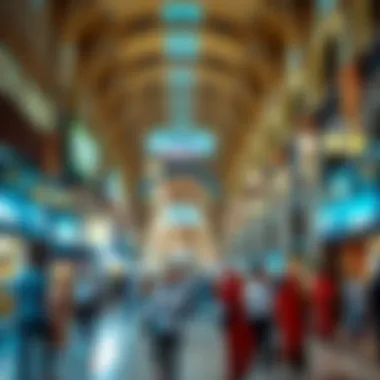

A Hub for Local Craftsmanship
At the core of Souk Naif Plaza lies an unwavering dedication to preserving and promoting local craftsmanship. With each stall representing hours of skilled labor, artisans present a myriad of goods that speak volumes about the Emirati culture. From intricately designed textiles to hand-carved wooden artifacts, visitors find themselves immersed in the unique artistry that each piece represents.
For instance, the small shops lined with colorful fabrics are often manned by skilled tailors who provide tailored garments that are emblematic of the region's fashion. This kind of personalized service embraces the custom of quality over quantity. Moreover, visitors can witness craftsmen at work, providing an authentic experience that simply can't be found in the large, sterile shopping malls.
"In Souk Naif, every purchase is not just a transaction; it’s a chance to support local artisans keeping tradition alive."
Festivals and Community Gatherings
Community spirit resonates throughout Souk Naif, particularly during various festivals and gatherings that take place all year round. These events are not only a showcase of local talent but also a way for residents and visitors to connect, share stories, and celebrate their cultural heritage. Festivals such as Eid al-Fitr bring throngs of people together, transforming the souk into a vibrant celebration of life, food, and tradition.
During such occasions, vendors often offer traditional sweets, handicrafts, and other goods that reflect the festive mood. Live performances, whether traditional dance or musical acts, create an atmosphere of joy and unity. These gatherings help foster relationships among community members and visitors alike, bridging cultural divides and allowing people to experience the warmth and hospitality the Emiratis are known for.
In summary, Souk Naif Plaza is not merely a shopping destination; it's a vibrant center of cultural significance. It serves to showcase local craftsmanship that carries stories of tradition, while also hosting adventures in community gatherings that cyclically enrich the experience of both locals and tourists.
Commercial Landscape of Souk Naif Plaza
In a city where contemporary marvels dominate the skyline, Souk Naif Plaza stands out as an enduring icon that marries commerce with cultural richness. It reflects a microcosm of Dubai's bustling market scene, where traditional practices coexist alongside modern trade dynamics. This section delves into the commercial landscape of Souk Naif Plaza, emphasizing its significance within the broader context of the emirate's economic framework.
Diverse Range of Merchandise
Souk Naif isn't just another market; it's a treasure trove of goods that speaks to both the local flavor and the broader commercial pulse of Dubai. The range of merchandise available is nothing short of diverse. From handcrafted Emirati souvenirs to vibrant textiles and intricate jewelry, each stall tells a story steeped in tradition and craftsmanship.
- Local Handicrafts: Visitors can find beautiful items such as traditional daggers, intricate pottery, and woven baskets that are not just goods, but expressions of local culture.
- Fashion Items: The conjunction of fashion and culture is notable. Visitors can explore a variety of clothing options, from contemporary styles to traditional attire like the abaya or kandora, catering to the tastes of both residents and tourists.
- Spices and Food Products: Dubai’s culinary landscape is encapsulated in the array of spices, dried fruits, and nuts available at the souk, giving shoppers a taste of the region’s rich gastronomic heritage.
The appeal of this diverse merchandise is that it caters to multiple demographics — from expats looking to bring home a piece of local culture to tourists wanting a unique souvenir. The prices, while generally accessible, reflect the quality and craftsmanship that define the products, making it an attractive shopping destination that competes well against modern retail environments.
Local Vendors vs. International Brands
The commercial ecosystem at Souk Naif Plaza is a fascinating interplay between local vendors and international brands, creating a vibrant tapestry of choice for shoppers. Local traders, often family-run businesses, have roamed the corridors of this plaza for generations. Their deep-rooted connections to the community allow them to offer products that are not merely goods but rather reflections of cultural heritage.
In contrast, international brands are increasingly drawn to this unique marketplace, recognizing the potential for engagement with a diverse audience. Some insights into this dynamic include:
- Authenticity vs. Globalization: Local vendors pride themselves on offering authentic goods, which fosters a sense of trust and connection with customers. International brands, on the other hand, often rely on marketing to position themselves favorably, sometimes diluting the local essence.
- Pricing Strategies: Local vendors frequently adopt flexible pricing strategies, whereas international brands tend to adhere to a more rigid pricing structure due to corporate policies. This often gives the edge to local merchants in win-win scenarios for those looking for both quality and affordability.
- Cultural Adaptation: In order to thrive in a diverse marketplace, some international brands have begun incorporating local elements into their offerings, thereby creating a unique fusion that appeals to both local and tourist demographics.
This interplay enhances the plaza's commercial viability, drawing in a unique mix of clientele looking for modern conveniences and traditional Qatar-style experiences in one fell swoop.
In summary, the commercial landscape of Souk Naif Plaza serves as a barometer for not only local economic health but also for the broader cultural exchange that encapsulates Dubai's multifaceted identity today.
Real Estate Dynamics Around Souk Naif Plaza
The real estate dynamics surrounding Souk Naif Plaza make it a vital subject within the grand narrative of Dubai's development and its ongoing allure. As one of the oldest marketplaces in the city, the area is not only a hotspot for visitors but also a valuable asset for residents and investors alike. The unique blend of traditional charm and modern commerce contributes to its significance in the market.
Being at the heart of Dubai, the real estate landscape around Souk Naif offers various benefits. Investors and property developers are keenly interested in this nexus due to its strategic location and cultural heritage, which promises sustained interest from locals and tourists alike. The synergy between cultural significance and commercial enterprise creates a vibrant local economy that consistently draws investment.
Investment Opportunities
Investing around Souk Naif Plaza gives potential buyers unique advantages that afford solid returns. Properties near this bustling marketplace are in high demand, partly because they cater to both retail and residential needs. With tourism on the rise, there’s a growing search for short-term rentals and hotel developments in the vicinity.
Key investment opportunities include:
- Retail Spaces: With a diverse range of local shops and international brands, retail spaces near Souk Naif promise fruitful returns due to high foot traffic.
- Residential Property: The plaza’s popularity makes nearby housing sought after by expatriates and locals, creating a competitive rental market.
- Mixed-Use Developments: Such projects combine commercial and residential opportunities, allowing for flexibility and increased revenue potential.
"The most successful investments in real estate are those that understand the cultural and commercial balance essential in areas like Souk Naif."
Property Trends and Market Analysis
The property market around Souk Naif is rarely static. Current trends indicate a noticeable shift toward modernized developments that still hold onto the traditional essence of the area. The local government’s emphasis on urban renewal plays a pivotal role, encouraging property developers to innovate while maintaining a connection to the rich history of the region.
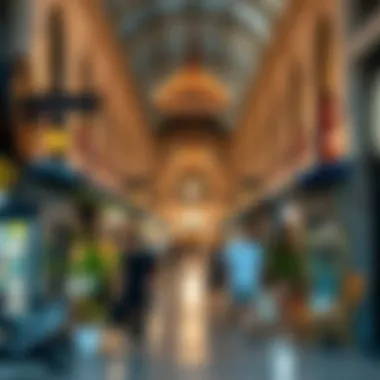

Market analysis reveals some prominent trends:
- Increased Tourist Influx: The perennial growth in tourism translates to a stronger demand for both commercial properties and accommodations, driving prices upward.
- Cultural Integration in Developments: New constructions often incorporate elements that reflect local history, appealing to both investors and residents who value cultural authenticity.
- Sustainability Practices: There’s a gradual shift towards eco-friendly developments that respect cultural identities while catering to a more environmentally-conscious populace.
Overall, as Souk Naif Plaza continues to thrive, the real estate around it is poised for growth, balancing community needs with lucrative investment possibilities.
Visitor Experience at Souk Naif Plaza
The visitor experience at Souk Naif Plaza is not just about shopping or dining; it encapsulates the essence of Dubai’s rich tapestry of culture and commerce. From the moment guests set foot in the plaza, they are greeted by a sensory overload of sights, sounds, and smells that reflects both the traditional and contemporary sides of the city. Here, one can observe the vibrant interaction among local artisans, shopkeepers, and tourists, creating a lively environment that is both welcoming and educational.
When visiting Souk Naif Plaza, tourists can take part in various activities that enhance their experience. With numerous shops offering local crafts and merchandise, the plaza serves as an excellent place for those looking to carry home a piece of Dubai's essence. Furthermore, understanding the layout and navigation before embarking on this cultural journey is crucial to maximize enjoyment.
Navigational Insights for Tourists
Navigating Souk Naif Plaza might seem daunting at first, especially with the numerous stalls and shops crammed into its lively pathways. However, with a few tips, tourists can maneuver through the market like seasoned locals. Here are some practical insights:
- Know the Entrance Points: Familiarize yourself with the main entrances to avoid getting lost. The primary entrance is located near Al Maktoum Road, making it easy to find and access.
- Map Out Your Interests: Whether it’s traditional textiles, spices, or souvenirs, deciding what you want to explore can help streamline your visit. An informal map is sometimes available at visitor centers to highlight key attractions.
- Timing is Key: The plaza tends to be less crowded during mid-week. Early morning visits can offer a more relaxed shopping experience, allowing for thoughtful exploration and interaction with vendors.
"In every corner, there's a story waiting to be discovered."
By keeping these points in mind, tourists can avoid the common pitfalls that might hinder their experience.
Dining and Refreshment Options
After exploring the myriad of shops, visitors might find themselves in need of a break. Souk Naif Plaza offers a variety of dining and refreshment options that cater to a wide array of tastes.
- Local Delicacies: Several eateries serve authentic Emirati cuisine, allowing diners to indulge in traditional dishes such as Shawarma and Kebabs. These meals often come served with a side of local hospitality.
- Cafés and Refreshments: For a lighter option, numerous cafés dot the plaza—perfect for grabbing a quick coffee or a burst of energy with refreshing Limonana, a local mint lemonade.
- Food Courts: The plaza features vibrant food courts where one can find various international cuisines, ensuring that even the pickiest eaters can find something to enjoy.
No matter where you choose to dine, each meal reflects the community's warm hospitality, making it a delightful conclusion to any shopping adventure. This experience is further enriched by the surrounding ambiance of the plaza, where laughter and chatter mingle with the aroma of sumptuous foods.
Sustainability Initiatives in Souk Naif
As the world leans increasingly toward sustainable practices, Souk Naif introduces initiatives that not only benefit local vendors but also align with the broader environmental goals of Dubai. In an area bustling with trade, the importance of sustainability can no longer be brushed aside. A reflective marketplace, Souk Naif seeks to marry tradition with modern eco-friendly ideas.
Eco-Friendly Practices of Vendors
Vendors at Souk Naif have begun to embrace eco-friendly practices. Many stall owners, recognizing the changing preferences of consumers, source products from environmentally-conscious suppliers. For instance, some artisans use organic materials in their crafts, such as cotton and bamboo, steering clear of synthetic alternatives that are harmful to the planet. This approach not only promotes a greener environment but also enhances the appeal of their goods to a more aware clientele.
Additionally, there’s an observable shift towards reducing plastic usage. Stores are increasingly offering biodegradable packaging options, and consumers are encouraged to bring their reusable bags. It's small steps like these that contribute significantly to reducing the carbon footprint of shopping at the souk.
- Examples of Eco-Friendly Vendor Practices:
- Usage of natural dyes in weaving and textiles.
- Selling local produce, thereby minimizing transportation emissions.
- Implementation of water-saving techniques in food stalls, which is vital in a desert city.
The collective effort of these vendors creates a ripple effect of consciousness about sustainability, inspiring others in the community to adopt similar practices.
Community Involvement in Sustainability
Community involvement plays a pivotal role in the sustainability initiatives at Souk Naif. Local groups and NGOs have taken the initiative to encourage environmental awareness among residents and visitors alike. Workshops are often held to inform people about recycling, waste management, and sustainable living.
Moreover, a collaborative effort has emerged among vendors, city officials, and citizens to participate in community clean-up events. These not only keep the plaza looking pristine but also foster camaraderie and a shared sense of purpose among participants. The community's commitment to preserving the cultural and physical heritage of Souk Naif is uplifting.
"A sustainable souk is not just about products; it’s about a lifestyle that resonates with our cultural identity."
The educational programs also cater to young minds, helping to instill in them the value of sustainability early on. School trips to the plaza become opportunities for discussing global issues like climate change and how individual actions matter.
- Significant Outcomes from Community Involvement:
- Increased awareness about recyclables, leading to better disposal habits.
- Strengthening the relationship between local artisans and ecologically-conscious consumers.
- Greater participation in resource-saving initiatives, contributing to improved waste management systems in the district.
Realizing the potential of uniting cultural heritage with sustainability, Souk Naif strives to be more than just a market. It embodies the ambition of its people and their commitment to a better future for Dubai.
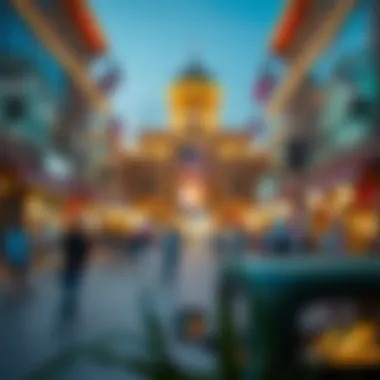

Challenges Facing Souk Naif Plaza
The realm of Souk Naif Plaza is not without its trials. Understanding these challenges is pivotal for grasping the full picture of what this cultural and commercial hub represents. This section dives into some of the pressing issues that impact the vitality and legacy of Souk Naif Plaza. These challenges not only affect local vendors but also matter to investors, expatriates, and anyone keen on the area's transformative potential.
Competition from Modern Shopping Malls
In the heart of Dubai, the rapid development of modern shopping malls poses a significant challenge to traditional marketplaces like Souk Naif Plaza. Malls such as The Dubai Mall and Mall of the Emirates lure shoppers with their air-conditioned comfort, international brands, and expansive offerings. While these modern constructs have become the go-to destinations for many, the allure of Souk Naif lies in its authenticity and connection to the past.
- Consumer Preferences: Many consumers are drawn to the convenience and variety provided by these immense shopping centers. The sleek aesthetics and consistent marketing appeal to a wide range of demographics, diverting traffic away from the more intimate setting of Souk Naif.
- Marketing and Promotions: Malls often leverage aggressive marketing strategies, offering discounts and promotions that are hard for small vendors to match. This drives the perception that malls offer better value, leaving smaller shops at a disadvantage.
- Shopping Experience: Malls provide an experience that is hard to compete with, including entertainment options, food courts, and recreational facilities, further entrenching their dominance in the consumer landscape.
Despite these hurdles, Souk Naif Plaza has unique characteristics that modern developments can’t replicate, such as its cultural richness and community spirit. Discussions around these challenges can drive innovative solutions to capture consumer interest and maintain the plaza's unique appeal.
Preservation of Cultural Identity
One of the most significant challenges facing Souk Naif Plaza is the threat to its cultural identity amidst urbanization and modernization efforts. As Dubai continues to grow and evolve into a global city, preserving the character and essence of this historic marketplace becomes increasingly complex.
- Cultural Heritage: Souk Naif has stood as a testament to Dubai's past—a reminder of the traditions that shaped the emirate. However, the influx of modern influences may dilute this heritage if not handled with care.
- Balancing Modernity and Tradition: Finding the right balance between modern conveniences and traditional charm is crucial. While upgrades and renovations can add value, over-commercialization risks alienating the very essence that draws visitors to Souk Naif.
- Community Engagement: Local vendors and the community must work hand in hand to ensure that the marketplace not only survives but thrives. Initiatives that engage locals in preserving traditional crafts and practices can help maintain the plaza's authenticity.
"Cultural identity is not merely linked to how something looks; it's ingrained in the very spirit of the space and the stories it holds."
In summary, the challenges posed by competition from modern shopping malls and the need for cultural preservation demand thoughtful consideration. Addressing these issues can help Souk Naif Plaza continue to flourish as both a commercial and cultural centerpiece of Dubai.
Future Prospects of Souk Naif Plaza
The future of Souk Naif Plaza is brimming with potential, making it a focal point for investors, residents, and culture enthusiasts alike. As Dubai continues to evolve into a global hub for tourism and commerce, the role of this historic plaza is set to expand further. The juxtaposition of tradition and modernization here plays a significant part in shaping the plaza's trajectory. Understanding the upcoming initiatives and the expected increase in foot traffic can provide valuable insights for stakeholders within the region.
Planned Developments and Upgrades
Planned developments for Souk Naif Plaza underscore a commitment to keeping the plaza relevant in today’s fast-paced world. Recent discussions among local authorities have hinted at several upgrades aimed at enhancing the visitor experience while preserving the unique charm that makes Souk Naif special. These plans include:
- Enhanced Infrastructure: Improvements to existing walkways and the installation of shaded seating areas to allow visitors to relax and enjoy their surroundings comfortably.
- Digital Integration: Smart technology solutions, like augmented reality guides, are envisioned to help tourists navigate the plaza and learn about the diverse offerings with a simple scan, merging tradition with innovation.
- Cultural Events: Regularly scheduled festivals showcasing local art, music, and cuisine are planned to draw more people into the area, transforming the plaza into a vibrant cultural hotspot.
These changes underscore an understanding not just of the marketplace but also of the cultural heartbeat of Dubai, ensuring its relevancy for future generations.
Potential Increase in Foot Traffic
With the planned developments, the potential increase in foot traffic at Souk Naif Plaza stands as a key consideration for investors and vendors alike. The anticipated uplift in visitor numbers may occur for several reasons:
- Expansion of Tourist Attractions: The enhanced visibility and access due to new attractions in the neighboring areas is likely to divert foot traffic towards the plaza, transforming it from just a pit stop to a must-visit destination.
- Community Engagement: As local events and cultural activities take center stage, more residents and tourists alike will find reasons to visit, creating a buzz that can lead to increased visitor loyalty and repeat business.
- Strategic Partnerships: Collaborations with hotels, tour companies, and local governments could serve to promote Souk Naif Plaza as a key stopping point for city tours, further solidifying its position in the local tourism ecosystem.
In sum, the future of Souk Naif Plaza is not only bright, but also pivotal in shaping the cultural and economic landscape of Dubai. Stakeholders should keep an eye on these developments as they unfold, for the plaza stands at the crossroads of tradition and modernity, promising a unique experience for all who venture into its vibrant expanse.
"Investing in local heritage sites like Souk Naif Plaza not only helps preserve cultural identity but also enhances economic stability for communities."
For further insights on Dubai’s evolving landscape, you can explore more through resources such as Wiki Travel, Britannica, or forums on Reddit.
Stay tuned for updates on the exciting future of Souk Naif Plaza.
The Role of Souk Naif Plaza in Dubai's Identity
In any vibrant city, certain locales find their way into the hearts of locals and visitors alike. Souk Naif Plaza stands as a beacon of Dubai's cultural and economic essence. This marketplace holds a unique place, serving as a microcosm of city life where tradition and modernity dance a delicate waltz. Understanding the role that Souk Naif Plaza plays in shaping Dubai's identity is crucial for anyone interested in the city's intricate social fabric and economic landscape.
Cultural Representation
Souk Naif is not just a shopping destination; it represents a living, breathing expression of Dubai’s culture. It showcases the city’s rich heritage through handcrafted items, traditional garments, and local spices. Each stall and corner tells a story, often reflecting the history that goes back generations.
Walking through the aisles, a visitor can sense this cultural pulse. Local artisans display their crafts, from intricate pottery to textiles, which embody the skills handed down through families. The marketplace is also a hub for language and interactions, where dialects of Arabic blend with English and other tongues, illustrating the melting pot that Dubai has become.
From festivals that fill its alleys with lively music and dance, to exhibitions that highlight local craftsmanship, Souk Naif fosters a sense of community pride. The space acts as a common ground, uniting individuals from all walks of life. It reminds each person, whether a tourist or a local, that at heart, Dubai values its heritage while simultaneously embracing the future.
Symbol of Economic Resilience
Beyond its cultural significance, Souk Naif Plaza serves as a symbol of economic resilience. Situated in a city known for its rapid growth and opulence, the plaza stands firm as a testament to the enduring appeal of traditional commerce amid modern malls and high-end boutiques.
In the face of competition from large shopping centers, Souk Naif has maintained its relevance. The blend of local vendors offering unique goods with the occasional presence of international brands creates an inviting market environment. This not only attracts tourists, but it also bears witness to the entrepreneurial spirit of local businessmen and women who find ways to thrive despite challenges.
The plaza’s ability to adapt, promote local products, and draw in a steady stream of customers makes it an essential component of Dubai's economy. Furthermore, its investment potential cannot be overlooked for those seeking business opportunities tied to Dubai's economic landscape.
Souk Naif Plaza is more than a market. It’s a crossroads of cultures, a platform for entrepreneurs, and a stronghold of tradition in a city defined by its skyscrapers and innovation.
